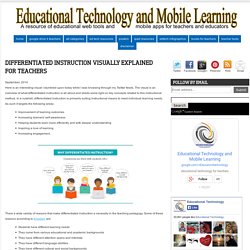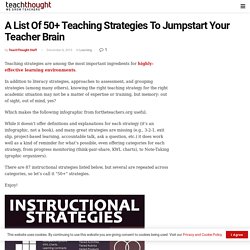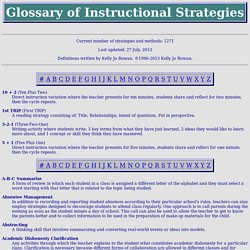

Middle School Level.
6 Steps to Differentiated Instruction. At the beginning of my teaching career I believed that effective differentiation consisted of sitting students in ability groups and producing three different level worksheets for each lesson.

I soon began to realize that this could produce a self fulfilling prophecy in students, believing that whichever group or worksheet they were assigned defined them as a student. Even the parents were aware of who was on the “top” or “bottom” table. I felt very uncomfortable with this labeling of children so young and began to research and experiment with a range of strategies to ensure all children are challenged and taught at an appropriate level. It often feels like spinning plates in the classroom, but these ideas have really helped to ensure that all students make accelerated progress without feeling disillusioned. Sometimes I differentiate by ability, by social skills, or by confidence in performing. 1. 2. 3. 4. 5. 6. Continual assessment and feedback is key to successful differentiation.
What is Differentiated Instruction? Differentiated Instruction Visually Explained for Teachers. September, 2014 Here is an interesting visual I stumbled upon today while I was browsing through my Twitter feeds.

The visual is an overview of what differentiated instruction is all about and sheds some light on key concepts related to this instructional method. In a nutshell, differentiated instruction is primarily suiting instructional means to meet individual learning needs. As such it targets the following areas: 32 Research-Based Instructional Strategies - 32 Research-Based Instructional Strategies by TeachThought Staff You want to teach with what’s been proven to work.

That makes sense. In the ‘data era’ of education that’s mean research-based instructional strategies to drive data-based teaching, and while there’s a lot to consider here we’d love to explore more deeply, for now we’re just going to take a look at the instructional strategies themselves. A post is not the best way to share this kind of information, honestly. But upside to sharing this information as a post is that it can act a starting point to research the above, which is why we’ve tried to include links, related content, and suggested reading for many of the strategies, and are trying to add citations for all of them that reference the original study that demonstrated that strategy’s effectiveness. How should you use a list like this?
“In lieu of any problems, this much data has to be useful. Effective Instructional Strategies That Boost Learning. Research-Based Instructional Strategies. A List Of 50+ Teaching Strategies To Jumpstart Your Teacher Brain. Teaching strategies are among the most important ingredients for highly-effective learning environments.

In addition to literacy strategies, approaches to assessment, and grouping strategies (among many others), knowing the right teaching strategy for the right academic situation may not be a matter of expertise or training, but memory: out of sight, out of mind, yes? Which makes the following infographic from fortheteachers.org useful. While it doesn’t offer definitions and explanations for each strategy (it’s an infographic, not a book), and many great strategies are missing (e.g., 3-2-1, exit slip, project-based learning, accountable talk, ask a question, etc.) it does work well as a kind of reminder for what’s possible, even offering categories for each strategy, from progress monitoring (think-pair-share, KWL charts), to Note-Taking (graphic organizers).
There are 87 instructional strategies listed below, but several are repeated across categories, so let’s call it “50+” strategies. 20 Differentiated Instruction Strategies & Examples. As students with diverse learning styles fill the classroom, many teachers don’t always have the time to plan lessons that use differentiated instruction (DI) to suit their distinct aptitudes. This can involve adjusting: Content — The media and methods teachers use to impart and instruct skills, ideas and informationProcesses — The exercises and practices students perform to better understand contentProducts — The materials, such as tests and projects, students complete to demonstrate understanding To help create lessons that engage and resonate with a diverse classroom, below are 20 differentiated instruction strategies and examples. Available in a condensed and printable list for your desk, you can use 16 in most classes and the last four for math lessons.
Try the ones that best apply to you, depending on factors such as student age. 1. Provide different types of content by setting up learning stations — divided sections of your classroom through which groups of students rotate. Glossary of Instructional Strategies. Current number of strategies and methods: 1271 Last updated: 27 July, 2013 Definitions written by Kelly Jo Rowan. ©1996-2013 Kelly Jo Rowan. 10 + 2 (Ten Plus Two) Direct instruction variation where the teacher presents for ten minutes, students share and reflect for two minutes, then the cycle repeats. 1st TRIP (First TRIP) A reading strategy consisting of: Title, Relationships, Intent of questions, Put in perspective. 3-2-1 (Three-Two-One) Writing activity where students write: 3 key terms from what they have just learned, 2 ideas they would like to learn more about, and 1 concept or skill they think they have mastered. 5 + 1 (Five Plus One)

Classroom Management Strategies. Get instant ideas from other teachers on how to manage your toughest behavior challenges.

Just click on a behavior issue below. How can a teacher prevent irritating classroom behaviors? 1. The students and teacher should first discuss and then write a "group" contract adopting acceptable classroom rules and procedures by the end of the first week of school. 2. 3. 4. 5.